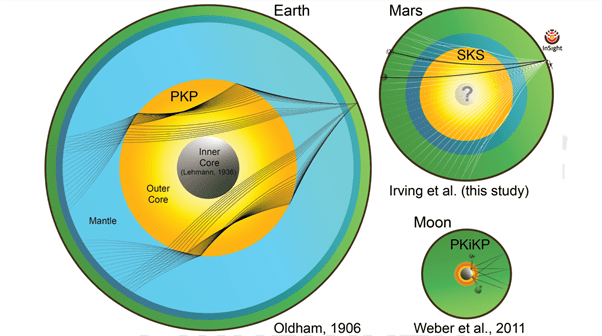The Martian liquid core is smaller, denser, and probably smells worse than previously thought, the InSight lander has revealed by capturing seismic waves originating on the other side of the planet.
Our knowledge of Earth’s core comes from more than a century of studying the distorting effect it has on waves from earthquakes on the other side of the world. Now, it’s another planet’s turn. When the InSight mission landed on Mars, planetary scientists hoped to learn something about local seismic action. Picking up quakes from the other side of the planet was an improbable dream, but one achieved thanks to the project’s longevity.
On Earth, seismographs can measure the shaking produced by nearby earthquakes, and this can be compared to results from the other side of the planet to study the changes produced by passage through the core. We’ve only had one seismic measuring device on Mars, which had to do it all – yet a new paper reveals this was enough to gain insights into the Martian core, using comparisons between waves taking a direct route and those bent through the mantle.
“Two seismic signals, one from a very distant marsquake and one from a meteorite impact on the far side of the planet, have allowed us to probe the Martian core with seismic waves,” said Dr Jessica Irving of the University of Bristol in a statement. “We’ve effectively been listening for energy travelling through the heart of another planet, and now we’ve heard it.”
The waves indicate the Martian core has a radius of 1,780-1,810 kilometers (1,106-1125 miles), a little smaller and denser than previous estimates based on reflected waves. Using the density calculated and the velocity of the passing waves, the authors sought a combination of common elements that under Martian conditions would match the measurements.
As Irving noted; “So-called ‘farside’ events […] are intrinsically harder to detect because a great deal of energy is lost or diverted away as waves travel through the planet.” Mars is also far less seismically active than Earth, so it wasn’t a surprise InSight didn’t pick up anything suitable during the Martian year of its intended operation. However, on day 976 of the mission, a farside marsquake was observed, followed 24 days later by a meteorite impact whose location could be traced precisely.

Schematics of the internal structures of Earth, Mars, and the Moon, including the paths of seismic waves used to make the initial discovery on Earth and now on Mars Image Credit: Irving et al, Proceedings of the National Academy of Sciences
Although the denser core might be expected to indicate the presence of heavy metals, the team thinks the opposite is the case. “Rather than being just a ball of iron, it also contains a large amount of sulfur, as well as other elements including a small amount of hydrogen,” Irving said. The paper estimates a fifth of the core’s mass is light elements such as these, oxygen and carbon, in contrast to Earth’s overwhelmingly iron-nickel core. The presence of so many non-magnetic elements may help explain why Mars lost its planetary magnetic field so quickly, with disastrous consequences.
The findings will sharpen models of Mars’ formation. “There are small traces of hydrogen in Mars’ core. That means that there had to be certain conditions that allowed the hydrogen to be there, and we have to understand those conditions in order to understand how Mars evolved into the planet it is today,” said Dr Vedran Lekić of the University of Maryland in a different statement.
The findings also have wider implications. We now have precise measurements of the inner workings of two planets, rather than just one, to use when trying to predict the compositions of the host of rocky planets being discovered around other stars.
The study is published in Proceedings of the National Academy of Sciences.
Source Link: Seismic Waves Reveal The Liquid Martian Core For The First Time